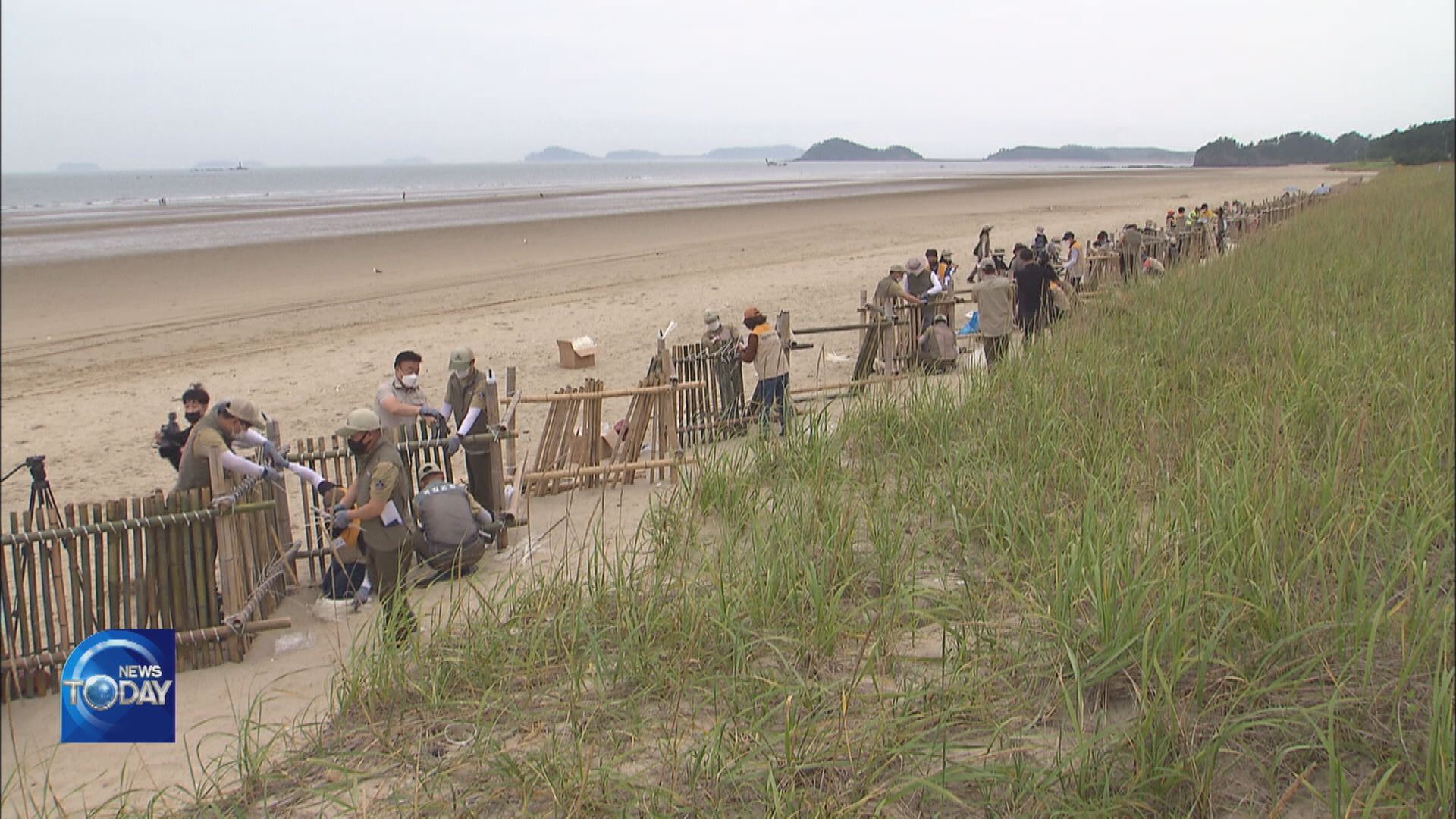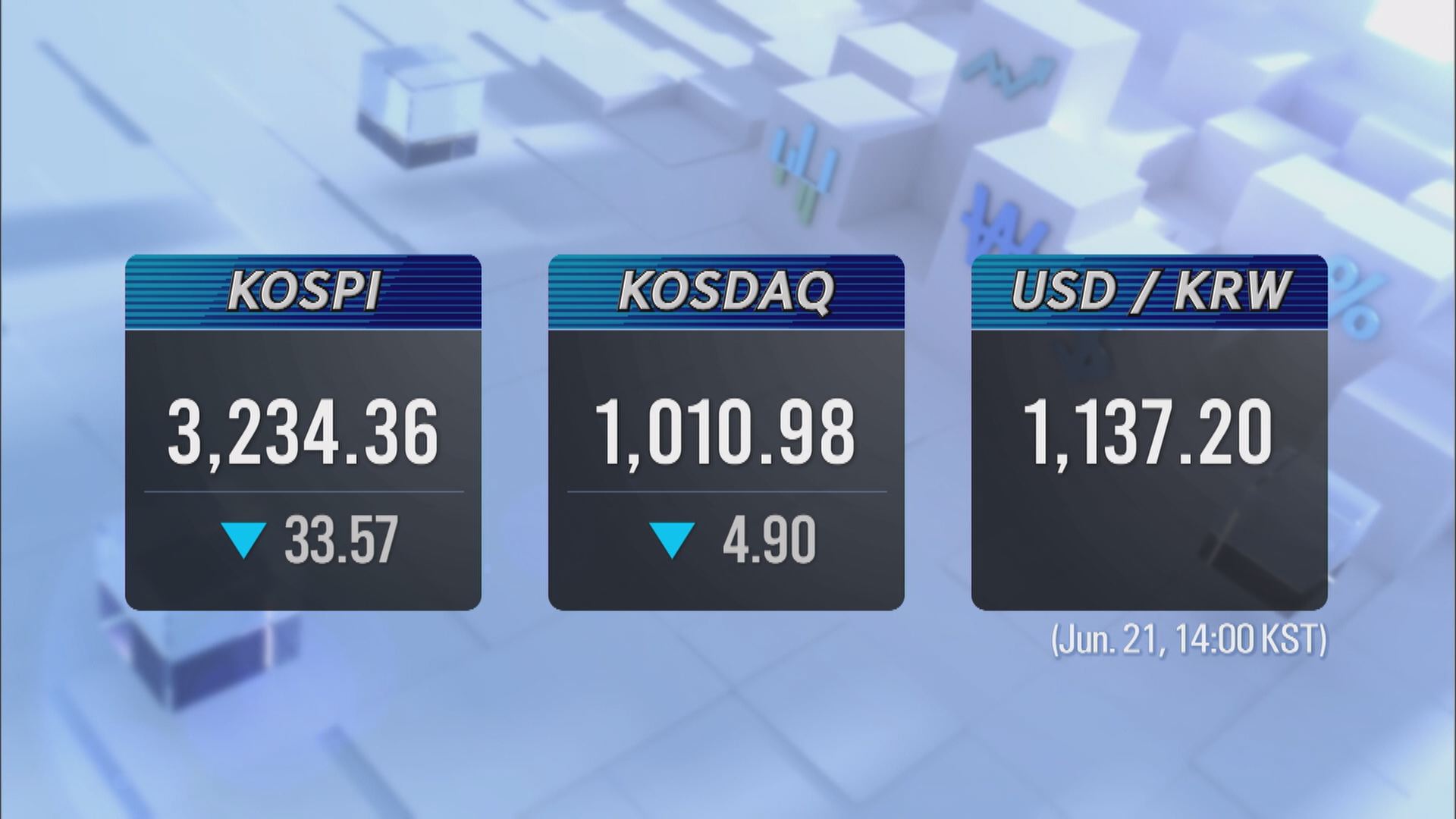RESTORATION OF COASTAL DUNE
입력 2021.06.21 (15:22)
수정 2021.06.21 (16:46)
읽어주기 기능은 크롬기반의
브라우저에서만 사용하실 수 있습니다.
[Anchor Lead]
While large reclamation or development projects exacerbates coastal erosion, the damaged coastal dune at Taeanhaean National Park in Chungcheongnam-do Province has been restored recently. Sand has accumulated along the coast again, thanks to a stretch of bamboo fencing.
[Pkg]
Gijipo Beach inside Taeanhaean National Park is famous for a long sandy beach. Now there is a new coastal sand dune along the shore. The dune is one kilometer long, about 20 meters wide and roughly 2 meters tall. Assorted fauna and flora such as the Mongolia racerunner, beach roses, and the beach morning glory inhabit the dune. Back in 2000, the dune had almost disappeared due to serious coastal erosion. But a restoration project in 2001 started to bring back the sand. Now, 20 years later, the coastal dune is back in its original form. The key to the success can be found in 1.2 meter-tall bamboo fences. They helped collect the sand driven by winds.
[Soundbite] Shin Dae-seop(Marine Resources Division, Taeanhaean National Park Office) : "The fences help collect sand, but also prevents strong waves from eroding the dunes."
Since 2001, the Korea National Park Service built 10.7 kilometers of such bamboo fences at 14 locations inside Taeanhaean National Park where coastal erosion was particularly severe. As a result, 117,000 tons of sand was collected to restore 6.6 hectares of coastal dunes. That's the size of nine football fields.
[Soundbite] Song Hyung-geun(Chairman, Korea National Park Service) : "Dunes serve as a natural embankment and provide beautiful natural scenery. Coastal dunes must be preserved and the damaged ones restored."
The KNPS plans to carry out coastal dune restoration projects at all marine and coastal national parks through to 2025.
While large reclamation or development projects exacerbates coastal erosion, the damaged coastal dune at Taeanhaean National Park in Chungcheongnam-do Province has been restored recently. Sand has accumulated along the coast again, thanks to a stretch of bamboo fencing.
[Pkg]
Gijipo Beach inside Taeanhaean National Park is famous for a long sandy beach. Now there is a new coastal sand dune along the shore. The dune is one kilometer long, about 20 meters wide and roughly 2 meters tall. Assorted fauna and flora such as the Mongolia racerunner, beach roses, and the beach morning glory inhabit the dune. Back in 2000, the dune had almost disappeared due to serious coastal erosion. But a restoration project in 2001 started to bring back the sand. Now, 20 years later, the coastal dune is back in its original form. The key to the success can be found in 1.2 meter-tall bamboo fences. They helped collect the sand driven by winds.
[Soundbite] Shin Dae-seop(Marine Resources Division, Taeanhaean National Park Office) : "The fences help collect sand, but also prevents strong waves from eroding the dunes."
Since 2001, the Korea National Park Service built 10.7 kilometers of such bamboo fences at 14 locations inside Taeanhaean National Park where coastal erosion was particularly severe. As a result, 117,000 tons of sand was collected to restore 6.6 hectares of coastal dunes. That's the size of nine football fields.
[Soundbite] Song Hyung-geun(Chairman, Korea National Park Service) : "Dunes serve as a natural embankment and provide beautiful natural scenery. Coastal dunes must be preserved and the damaged ones restored."
The KNPS plans to carry out coastal dune restoration projects at all marine and coastal national parks through to 2025.
■ 제보하기
▷ 카카오톡 : 'KBS제보' 검색, 채널 추가
▷ 전화 : 02-781-1234, 4444
▷ 이메일 : kbs1234@kbs.co.kr
▷ 유튜브, 네이버, 카카오에서도 KBS뉴스를 구독해주세요!
- RESTORATION OF COASTAL DUNE
-
- 입력 2021-06-21 15:22:44
- 수정2021-06-21 16:46:30

[Anchor Lead]
While large reclamation or development projects exacerbates coastal erosion, the damaged coastal dune at Taeanhaean National Park in Chungcheongnam-do Province has been restored recently. Sand has accumulated along the coast again, thanks to a stretch of bamboo fencing.
[Pkg]
Gijipo Beach inside Taeanhaean National Park is famous for a long sandy beach. Now there is a new coastal sand dune along the shore. The dune is one kilometer long, about 20 meters wide and roughly 2 meters tall. Assorted fauna and flora such as the Mongolia racerunner, beach roses, and the beach morning glory inhabit the dune. Back in 2000, the dune had almost disappeared due to serious coastal erosion. But a restoration project in 2001 started to bring back the sand. Now, 20 years later, the coastal dune is back in its original form. The key to the success can be found in 1.2 meter-tall bamboo fences. They helped collect the sand driven by winds.
[Soundbite] Shin Dae-seop(Marine Resources Division, Taeanhaean National Park Office) : "The fences help collect sand, but also prevents strong waves from eroding the dunes."
Since 2001, the Korea National Park Service built 10.7 kilometers of such bamboo fences at 14 locations inside Taeanhaean National Park where coastal erosion was particularly severe. As a result, 117,000 tons of sand was collected to restore 6.6 hectares of coastal dunes. That's the size of nine football fields.
[Soundbite] Song Hyung-geun(Chairman, Korea National Park Service) : "Dunes serve as a natural embankment and provide beautiful natural scenery. Coastal dunes must be preserved and the damaged ones restored."
The KNPS plans to carry out coastal dune restoration projects at all marine and coastal national parks through to 2025.
While large reclamation or development projects exacerbates coastal erosion, the damaged coastal dune at Taeanhaean National Park in Chungcheongnam-do Province has been restored recently. Sand has accumulated along the coast again, thanks to a stretch of bamboo fencing.
[Pkg]
Gijipo Beach inside Taeanhaean National Park is famous for a long sandy beach. Now there is a new coastal sand dune along the shore. The dune is one kilometer long, about 20 meters wide and roughly 2 meters tall. Assorted fauna and flora such as the Mongolia racerunner, beach roses, and the beach morning glory inhabit the dune. Back in 2000, the dune had almost disappeared due to serious coastal erosion. But a restoration project in 2001 started to bring back the sand. Now, 20 years later, the coastal dune is back in its original form. The key to the success can be found in 1.2 meter-tall bamboo fences. They helped collect the sand driven by winds.
[Soundbite] Shin Dae-seop(Marine Resources Division, Taeanhaean National Park Office) : "The fences help collect sand, but also prevents strong waves from eroding the dunes."
Since 2001, the Korea National Park Service built 10.7 kilometers of such bamboo fences at 14 locations inside Taeanhaean National Park where coastal erosion was particularly severe. As a result, 117,000 tons of sand was collected to restore 6.6 hectares of coastal dunes. That's the size of nine football fields.
[Soundbite] Song Hyung-geun(Chairman, Korea National Park Service) : "Dunes serve as a natural embankment and provide beautiful natural scenery. Coastal dunes must be preserved and the damaged ones restored."
The KNPS plans to carry out coastal dune restoration projects at all marine and coastal national parks through to 2025.
이 기사가 좋으셨다면
-
좋아요
0
-
응원해요
0
-
후속 원해요
0














![[단독] 골프연습장 아니라더니<br>…‘한남동 골프연습장’ 도면 입수](/data/news/2025/07/01/20250701_Uh8Jnu.png)


이 기사에 대한 의견을 남겨주세요.